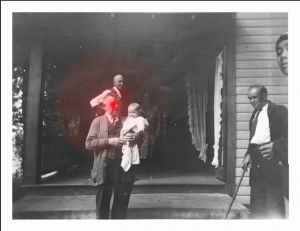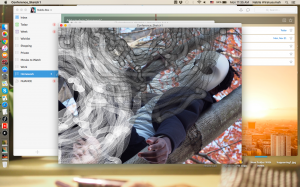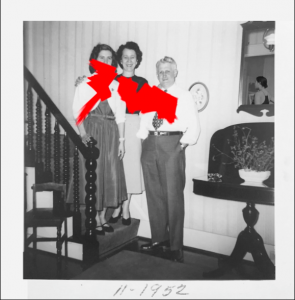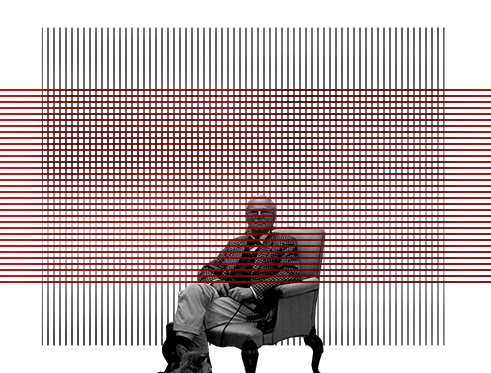For my conference project I created a series of movies that explored my placement in an American context and the ways in which I could use Processing and generative art to challenge or alter the original narrative of the photograph.
I began by finding photographs of American families in Ithaca. I then photoshopped myself into the images and split them into .jpg and .png files with some transparent portions so that I would be able to code in-between the layers.
The code itself was rendered in pure red to emulate the aesthetic of Barbara Kruger’s work. Many of the aesthetic techniques used were also reminiscent of John Baldessari’s dot series, where the graphic obstructions not only created visual tension, but also added a psychological distance between the viewer and the subjects of the photographs.
When I first began the project, all I knew is that I wanted to use photographs so I would have some tension between the coded graphics and the photographic image. However, I was at a loss for what photographs to use, and the approach I wanted to take. For a while I was browsing through old photos that I had taken. There was no real system, I was just looking for ones that caught my eye. Because there was a lack of purpose, I found it hard to make anything really interesting.
The idea for this slightly more political approach to the project came to me while I was in a thrift store, browsing through various old knick-knacks that, to me, were strongly representative of a specific American narrative. This was just a few weeks after the disheartening election results, and I was questioning my place and future in this country. I had used old found photographs for a previous project whilst I was studying in Berlin, and I knew the existing power and narrative in their composition would provide a fruitful grounding for my project.
Funnily enough, it was the pieces that I hadn’t previously sketched and planned for that turned out to be some of my favorites. Particularly, No.4 and No.5 in my series. I think when I started planning them in my sketchbook first, I was too focused on how to control the code, rather than how to create a system in which the generative nature of my work could create an interesting effect itself.
I also at one point became too reliant on Baldessari’s visual techniques. In No.1, I struggled to manipulate the spirals so that they wouldn’t just end up forming red dots on the faces in the photo, as it would be too similar to the dot series. In the end, I created a piece that changed very incrementally over time, and I think the difference before and after is quite striking. 


This change over time was definitely something I wanted to incorporate into my sketches, to make the photographs more dynamic and so that I could take full advantage of the properties of generative art. I was surprised to find that the vertex drawings I did, and changing them incrementally over time, wasn’t as hard as I thought it would be.
For No.2, I assigned variables to each vertex point of each shape, and added a noise incrementation so that they seemed to be expanding and growing in a somewhat organic fashion.
In every sketch, the axes that crossed particular portions of the photograph were very important. Mostly, I aligned the sketches to an axis that crossed over the eyes of the subjects. Though I wanted to differentiate myself from Baldessari, I also recognized that distracting and obstructing the face often had the most jarring effect on the viewer.
I also used loops in most, if not all, of my sketches. The allowed me to create these graphic accumulations onto of the images.
Because I was pretty excited about this project, time management wasn’t too much of an issue. However, I wasn’t quite aware when I started how many steps there would be. The process involved going to a number of thrift stores and flea markets, carefully selecting images, scanning them in, editing myself into them, creating the code, then finally creating the movie files. What took the most time was creating the code, but I did feel myself growing more comfortable with the code. I was much more careful with commenting out which code did what, which gave allowed me to navigate through the code more easily. Though control isn’t the ultimate goal of generative art, the ability to understand my code more easily gave me a certain measure of clarity so I could ensure that my goals would be fulfilled in the project.
One of my main concerns would be whether or not the insertion of myself into the images is fully necessary or even noticeable in many of the pieces. Aside from the wedding photo, I inserted myself into the periphery of the images, purposely out of the main line of site.
With No. 4, I feel as though suddenly it becomes noticeable that, of all the faces turned towards the camera, only mine isn’t obstructed in the end. No.1 also has me in the periphery, and when the image turns red and everyones eyes are marked out, mine is the only one left.
However, with No.2, I inserted myself with my back turned. I’m not sure if my insertion here is done to any effect, really. And the accumulations on the three main subjects, while it erases them, doesn’t distract from them at all. In fact, my focus has mainly stayed on them.
At the end of the day, I’m quite proud of what I accomplished with this project. I like the series as a whole, and I think the pieces do quite well together. I think the red on the high contrast black and white photographs is quite striking, and I think I definitely achieved my goal in changing the narrative and nature of the photographs throughout the series.


